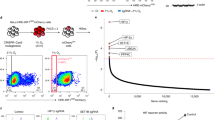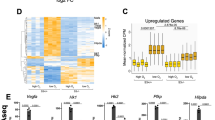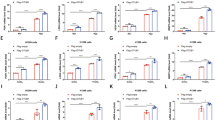Abstract
Oxygen deprivation (hypoxia) results in reprogrammed gene expression patterns that induce multifaceted cellular responses. Here we identify a regulated interaction between the serine/threonine kinase HIPK2 and the ubiquitin E3 ligase Siah2 as a mechanism controlling the hypoxic response. Under normoxic conditions, several mechanisms ensure HIPK2 stability: only a fraction of HIPK2 is found in association with Siah2, whereas HIPK2-mediated phosphorylation of this E3 ligase at positions 26, 28 and 68 weakens mutual binding and destabilizes its phosphorylated interaction partner. Hypoxic conditions allow a markedly increased HIPK2/Siah2 interaction and result in efficient polyubiquitylation and proteasomal degradation of the kinase. Accordingly, hypoxia-induced HIPK2 elimination is markedly reduced in Siah2-deficient cells. As HIPK2 has an important role as a negative regulator of gene expression, its elimination from promoter-associated repressor complexes allows the induction of a substantial fraction of hypoxia-induced genes.
This is a preview of subscription content, access via your institution
Access options
Subscribe to this journal
Receive 12 print issues and online access
$209.00 per year
only $17.42 per issue
Buy this article
- Purchase on Springer Link
- Instant access to full article PDF
Prices may be subject to local taxes which are calculated during checkout





Similar content being viewed by others
References
Hofmann, T. G. et al. Regulation of p53 activity by its interaction with homeodomain-interacting protein kinase-2. Nature Cell Biol. 4, 1–10 (2002).
D'Orazi, G. et al. Homeodomain-interacting protein kinase-2 phosphorylates p53 at Ser 46 and mediates apoptosis. Nature Cell Biol. 4, 11–19 (2002).
Kanei-Ishii, C. et al. Wnt-1 signal induces phosphorylation and degradation of c-Myb protein via TAK1, HIPK2, and NLK. Genes Dev. 18, 816–829 (2004).
Roscic, A. et al. Phosphorylation-dependent control of Pc2 SUMO E3 ligase activity by its substrate protein HIPK2. Mol. Cell 24, 77–89 (2006).
Gresko, E. et al. Autoregulatory control of the p53 response by caspase-mediated processing of HIPK2. EMBO J. 25, 1883–1894 (2006).
Rinaldo, C. et al. MDM2-regulated degradation of HIPK2 prevents p53 Ser 46 phosphorylation and DNA damage-induced apoptosis. Mol. Cell 25, 739–750 (2007).
Winter, M. et al. Control of HIPK2 stability by ubiquitin ligase Siah-1 and checkpoint kinases ATM and ATR. Nature Cell Biol. 10, 812–824 (2008).
Choi, D. W. et al. Ubiquitination and degradation of homeodomain-interacting protein kinase 2 by WD40 repeat/SOCS box protein WSB-1. J. Biol. Chem. 283, 4682–4689 (2008).
Shima, Y. et al. PML activates transcription by protecting HIPK2 and p300 from SCFFbx3-mediated degradation. Mol. Cell Biol. (2008).
Kanei-Ishii, C. et al. Fbxw7 acts as an E3 Ubiquitin ligase that targets c-Myb for nemo-like kinase (NLK)-induced degradation. J. Biol. Chem. (2008).
Nakayama, K. et al. Siah2 regulates stability of prolyl-hydroxylases, controls HIF1α abundance, and modulates physiological responses to hypoxia. Cell 117, 941–952 (2004).
Nakayama, K., Gazdoiu, S., Abraham, R., Pan, Z. Q. & Ronai, Z. Hypoxia-induced assembly of prolyl hydroxylase PHD3 into complexes: implications for its activity and susceptibility for degradation by the E3 ligase Siah2. Biochem. J. 401, 217–226 (2007).
Pouyssegur, J., Dayan, F. & Mazure, N. M. Hypoxia signalling in cancer and approaches to enforce tumour regression. Nature 441, 437–443 (2006).
Lieser, S. A., Aubol, B. E., Wong, L., Jennings, P. A. & Adams, J. A. Coupling phosphoryl transfer and substrate interactions in protein kinases. Biochim. Biophys. Acta 1754, 191–199 (2005).
Frasor, J., Danes, J. M., Funk, C. C. & Katzenellenbogen, B. S. Estrogen downregulation of the corepressor N-CoR: mechanism and implications for estrogen derepression of N-CoR-regulated genes. Proc. Natl Acad. Sci. USA 102, 13153–13157 (2005).
Rinaldo, C., Siepi, F., Prodosmo, A. & Soddu, S. HIPKs: Jack of all trades in basic nuclear activities. Biochim. Biophys. Acta 1783, 2124–2129 (2008).
Oda, K. et al. p53AIP1, a potential mediator of p53-dependent apoptosis, and its regulation by Ser-46-phosphorylated p53. Cell 102, 849–862 (2000).
Li, X. F. et al. Visualization of hypoxia in microscopic tumors by immunofluorescent microscopy. Cancer Res. 67, 7646–7653 (2007).
Qi, J. et al. The ubiquitin ligase Siah2 regulates tumorigenesis and metastasis by HIF-dependent and -independent pathways. Proc. Natl Acad. Sci. USA (2008).
Moller, A. et al. Inhibition of Siah ubiquitin ligase function. Oncogene (2008).
Kaelin, W. G., Jr. & Ratcliffe, P. J. Oxygen sensing by metazoans: the central role of the HIF hydroxylase pathway. Mol. Cell 30, 393–402 (2008).
Kenneth, N. S. & Rocha, S. Regulation of gene expression by hypoxia. Biochem. J. 414, 19–29 (2008).
Boehm, J., He, Y., Greiner, A., Staudt, L. & Wirth, T. Regulation of BOB.1/OBF.1 stability by SIAH. EMBO J. 20, 4153–4162 (2001).
Hara, M. R. et al. S-nitrosylated GAPDH initiates apoptotic cell death by nuclear translocation following Siah1 binding. Nature Cell Biol. 7, 665–674 (2005).
Di Stefano, V., Rinaldo, C., Sacchi, A., Soddu, S. & D'Orazi, G. Homeodomain-interacting protein kinase-2 activity and p53 phosphorylation are critical events for cisplatin-mediated apoptosis. Exp. Cell Res. 293, 311–320 (2004).
Acknowledgements
We are grateful to Stephanie Wack for excellent technical assistance, Michael Kracht for inspiring discussions and Elena Puccetti (Frankfurt) for help with microarrays. Our work is supported by grants from the Deutsche Forschungsgemeinschaft projects SCHM 1417/4-1, SCHM 1417/5-1, SFB 547 and the ECCPS - Excellence Cluster Cardio-Pulmonary System. M.A.C has been partially co-funded by the ISCIII-RETIC RD06/006 (RIS).
Author information
Authors and Affiliations
Contributions
M.A.C. designed and performed the experiments; L.d.l.V. and A.M. performed experiments; D.D.B. contributed conceptual input; M.L.S. supervised the whole project.
Corresponding author
Ethics declarations
Competing interests
The authors declare no competing financial interests.
Supplementary information
Supplementary Information
Supplementary Information (PDF 4137 kb)
Rights and permissions
About this article
Cite this article
Calzado, M., de la Vega, L., Möller, A. et al. An inducible autoregulatory loop between HIPK2 and Siah2 at the apex of the hypoxic response. Nat Cell Biol 11, 85–91 (2009). https://doi.org/10.1038/ncb1816
Received:
Accepted:
Published:
Issue Date:
DOI: https://doi.org/10.1038/ncb1816
This article is cited by
-
HMGB1-induced activation of ER stress contributes to pulmonary artery hypertension in vitro and in vivo
Respiratory Research (2023)
-
Helicobacter pylori-induced gastric cancer is orchestrated by MRCKβ-mediated Siah2 phosphorylation
Journal of Biomedical Science (2021)
-
Exosomal miR-1260b derived from non-small cell lung cancer promotes tumor metastasis through the inhibition of HIPK2
Cell Death & Disease (2021)
-
Betulinic Acid Hydroxamate is Neuroprotective and Induces Protein Phosphatase 2A-Dependent HIF-1α Stabilization and Post-transcriptional Dephosphorylation of Prolyl Hydrolase 2
Neurotherapeutics (2021)
-
HIPK2 suppresses tumor growth and progression of hepatocellular carcinoma through promoting the degradation of HIF-1α
Oncogene (2020)



